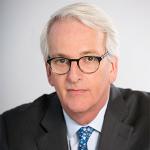One of the most important choices any president-elect must make is how to organize and staff the National Security Council (NSC). Chief executives from John Fitzgerald Kennedy to William Jefferson Clinton have found their foreign policy held hostage to the management choices they made between election and inauguration.
Today’s challenge is to refocus the organization on its primary, critical role. For as it has grown in size, the NSC has become more like an agency than a presidential staff. It is immersed in policy detail and focuses predominantly on the short-term. It does not give sufficient attention to the critical task that it alone can perform: coordinating the policy process so that, simultaneously, agencies get a full and fair hearing and the president can make clear foreign policy choices in a timely manner.
The new president must ensure that this key function is restored. To do so, he must cut the NSC’s size, simplify its structure, and enhance its seniority.
POLICY BRIEF #68
Background
The NSC was established in 1947 to integrate U.S. foreign and defense policy. By law, the Council is the United States government’s most exalted official committee, composed of just four members: the president, vice president, secretary of state, and secretary of defense. In practice, the NSC has become a presidential staff of foreign policy experts headed by the assistant to the president for national security affairs, who has been a key foreign policy player in every administration since John F. Kennedy’s.
Over the years, the NSC has expanded from a small, presidential staff of about ten policy people in the early 1960s to what is today a fully ensconced, agency-like organization of 225 people, including about 100 substantive professionals. This organization has its own perspective on the myriad of national security issues confronting the government. It has become less like a staff and more like an operating agency. With its own press, legislative, communication, and speechmaking offices, the NSC today conducts ongoing relations with the media, Congress, the American public, and foreign governments.
There are compelling reasons why the NSC has evolved in this way. But this evolution has created serious problems. As the NSC has become more like an agency, it has become less flexible and less adaptable, and its procedures more rigid and bureaucratic. Moreover, with its immersion in policy detail, the predominant focus of its work has become short-term, with the immediate crowding out the important. Finally, with its bureaucratization there is an increasing risk that the NSC will ignore the few critical tasks for which it is uniquely suited, including:
- Managing the president’s daily foreign policy activity, including his communication with foreign leaders and the preparation and conduct of his trips overseas;
- Coordinating the process by which policy on major foreign and national security issues is made by ensuring that those with strong stakes in the issue are involved in the process, and that all realistic policy options have been considered and fully analyzed—including options not favored by any agency—before they reach the president and his senior advisers for decision;
- Driving the policymaking process to make real choices, in a timely manner;
- Monitoring implementation of the decisions made by the president and his advisers.
The president-elect faces a critical decision on how to staff and organize his foreign policy team. Not all his predecessors chose wisely. Jimmy Carter mortgaged his future by choosing a national security adviser who was incompatible, in substantive views and operating style, with his secretary of state. Ronald Reagan first downgraded the NSC, then did nothing to end the conflict between the State Department, the Pentagon, and CIA, that he guaranteed by appointing bitter adversaries to head each of them.
As these examples suggest, the president needs to choose capable, compatible people to head the major foreign policy and national security departments and agencies. But their ability to function as a team ultimately depends on how he decides to staff and structure the NSC. The path of least resistance would be to replicate the current structure. But that would be a mistake. Before he makes any decision on the NSC, the president-elect needs to understand both why power has gravitated to the NSC and how this has imposed real costs on the foreign policies of his predecessors. It is against that backdrop that we offer our recommendations for a smaller, smarter, and more senior NSC staff—one that focuses first and foremost on effective management of the policy process.
The NSC’s Expanding Power
The evolution of the NSC from a small presidential staff to a major White House institution is the product of at least three different forces. First and fundamental is the half-century development and legitimization of the NSC as presidential coordinator for mainstream national security issues. Second is the post-cold war expansion of the foreign policy agenda, with more issues that require coordination across more agencies. Third is the deepening of partisanship in Washington, particularly over the last decade.
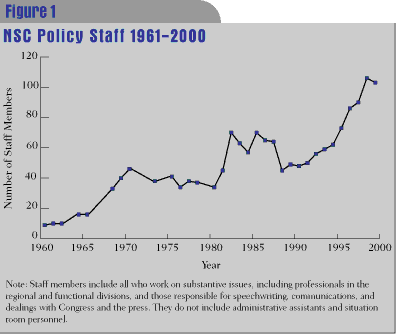
The Half-Century Evolution of the NSC
In its initial years, the NSC existed principally as a means to help the president develop broad policy. Harry S. Truman inaugurated it by creating a staff and providing for regular meetings, though he took care that the power of final decision remained his alone. Dwight D. Eisenhower institutionalized it, establishing an elaborate process of drafting policy papers and presiding over weekly meetings at which these papers were debated by his cabinet secretaries and senior advisers.
But major change came to the NSC in the 1960s. John F. Kennedy personalized it, slashing the NSC staff from an elaborate structure of fifty-plus professionals to an activist ten who served him directly on the hot issues of the day. Lyndon B. Johnson continued it, though he curbed staff challenges to senior officials and relied more on his secretary of state than Kennedy had done. And Richard M. Nixon transformed it: his determination to run foreign policy from the White House, his distrust of the State Department, and his close policy relationship with Henry A. Kissinger made the NSC more dominant than it had ever been before (or would be since).
By the early 1970s, the NSC staff had expanded to forty-plus substantive officials, with regional offices spanning the globe and functional experts dealing with issues like arms control and international economic interdependence. Gerald R. Ford normalized it, relying heavily on Kissinger (then secretary of state) and naming as his national security adviser the quintessential policy manager, Brent Scowcroft. Jimmy Carter indulged it, by appointing the brilliant and free-wheeling Zbigniew Brzezinski as national security adviser. The resulting conflict between Brzezinski and Secretary of State Cyrus Vance produced a crisis of confidence in the policy process, as well as in the substance of U.S. foreign policy.
Ronald Reagan responded by initially downgrading the national security adviser position. But he mainly neglected the NSC, with consequences seen in bitter interdepartmental conflict and culminating in the Iran-Contra scandal. George Bush professionalized it, building on reforms made in Reagan’s last two years, bringing back Scowcroft as security adviser and working closely with him and his exceptionally experienced, collegial group of senior aides. Bill Clinton broadened it in ways that have made the NSC more like a government agency—preoccupied with the many details of daily foreign policy—and less like a presidential staff focused on managing a competitive policy process.
But all these presidents used the NSC. And despite its tendency to take its color and shape from the reigning president, despite the fact that the staff changes with each presidential transition and finds empty file drawers in their new offices, it has endured and been institutionalized. The White House Situation Room, established under Kennedy, has become the focal point for crisis management. The NSC communications system, also inaugurated under Kennedy and growing progressively more sophisticated technically ever since, allows staff to monitor the overseas messages sent to and from the State Department, to have access to major intelligence material, and to communicate directly and secretly with foreign governments. Over time, these capacities, together with continuing presidential need and perceived State Department inadequacy, have built the National Security Council into a strong, entrenched, and legitimate presidential institution.
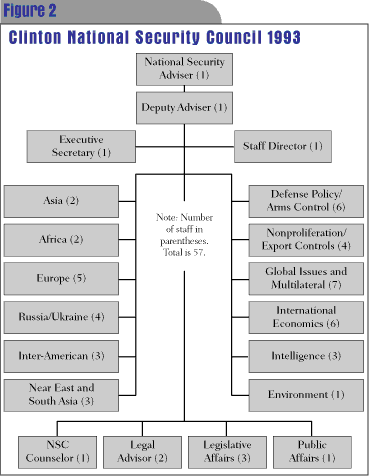
The Complexity of the Issue Agenda
The second main reason for the growth of the NSC is that, since the end of the cold war, the number of issues requiring White House attention has increased. The long-recognized dividing line between foreign and domestic policy has blurred, if not disappeared altogether. Questions like the global environment, combating infectious diseases, and protection against domestic terrorism do not fit neatly on one side or the other. Similarly, the economics-security divide has lost much of its meaning: in U.S. policy toward Russia and China, questions of trade and investment rank as high as issues like weapons proliferation.
As a result of these changes, a national security adviser is as likely today to confront decisions relating to global environmental negotiations or a complex humanitarian emergency in a distant locale, as a pending summit meeting with the Russian president or an updating of the security alliance with Japan.
In contrast to the more traditional issues (which involve a limited number of well-known executive branch players accustomed to working within a coordinated interagency system), the range of players with equity in these newer policy questions is far greater. Thus, environmental policy involves the State, Defense, Energy, and Treasury Departments, the Office of Management and Budget, and the Environmental Protection Agency—not to mention congressional and private interests vying for influence over policy. Domestic anti-terrorism involves State, Justice, Defense, Energy, Transportation, and Treasury, liaison with the Central Intelligence Agency on the international connections, and law enforcement and public health agencies at the federal, state, and local level.
Someone must coordinate these disparate players if effective action is to result. In most instances, White House officials are in a better position to do so than departmental actors, and more trusted by competing interests. And within the White House, the NSC has by far the strongest policy coordination record, so it is not surprising that it has been tasked with new substantive responsibilities, whether or not it is fitted for them. To meet these needs, the NSC has broadened its organizational competencies, adding directorates dealing with transnational threats, multilateral and humanitarian affairs, nonproliferation and export controls, and environmental and even international health policy. And it has more than doubled in size, from just over 40 professionals in 1991 to over 100 at the end of the decade, close to one-third of whom work on these non-traditional issues.
The Politicization of Foreign Policy
A final reason for the NSC’s growth is the altered political climate at home. Congress has become far more polarized ideologically. In the Senate, traditionally the more collegial of the two houses, the National Journal voting survey for 1999 found every Democrat to the left of every Republican. The lack of comity between the two parties in the House was showcased in the bitter 1998 debate over the president’s impeachment. Congress is also increasingly distant from the internationalist and frequently bipartisan tradition of the cold war years, with 50 new senators and 353 new representatives elected since 1990.
None of this political change has anything to do with overall public sentiment, which remains predominantly centrist and internationalist. But polarized Washington politics feed on foreign as well as domestic issues. Few if any are easily separated from partisan turmoil—not military intervention, not diplomatic relations, and certainly not trade and economic interactions with the outside world.
The White House is at once party to, and victim of, this polarization. It drives the president to give greater weight to domestic politics on international issues—both to protect his flank and to advance his party’s agenda. It renders the opposition less accessible to serious policy consultation and bridge-building. It pulls the national security adviser closer to the political side of the White House. And it pushes the secretary of state, normally less attuned to partisan matters, farther away from the mix of factors the president will weigh in making decisions. All these forces were at play in the disastrous Senate rejection of the nuclear test ban treaty in 1999.
Growing partisanship has had a clear impact on NSC operations. Although direct involvement in politics remains taboo for all but the national security adviser, much staff time is devoted to developing arguments for persuading a wary public and a distrustful Congress of the correctness of the administration’s foreign policy course. Not only has the NSC staff been augmented by people who develop communications strategies, manage press relations, and write foreign policy speeches, but policy directorates themselves devote an inordinate amount of time preparing talking points for senior officials, talking to reporters, and dealing with congressional staff—all in an effort to sell the administration’s policy line. At a time of growing polarization and partisanship, it often falls to those closest to the president—the NSC in the case of foreign policy—to do this in an effort to ensure policy is pursued effectively.
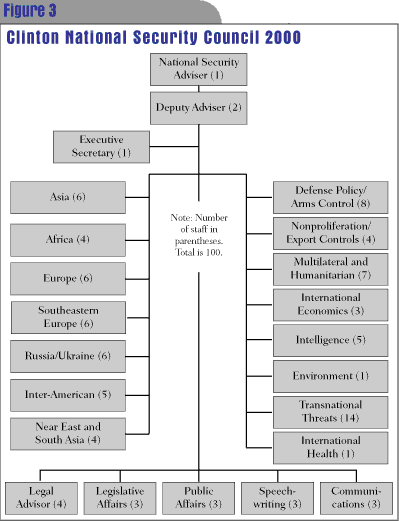
Avoiding Past Pitfalls
As the size and scope of the NSC continues to grow, there is an increasing risk that the staff and its operations will fall victim to one or more of the following pitfalls that have beset past administrations. Not all of these have characterized operations under Clinton. But any or all are likely to recur if present trends continue:
An Operational NSC.
If a small NSC coterie conducts foreign policy operations on a particular issue in secret and without involvement of other agencies, they are immune from effective staff review. And public trust is undercut when cabinet officials, responsible for informing Congress, are “out of the loop.” Iran-Contra demonstrated the extreme destructiveness of such an operational NSC system. And Henry Kissinger’s penchant to use backchannels with Moscow and Beijing, while effective in the short run, undermined the president in the long run as those who had been excluded worked to reverse the “détente” policy Nixon and Kissinger had put into place vis-à-vis the Soviet Union.
Of course, not all operational activities are deleterious to the process. Sometimes, direct involvement of the national security adviser provides the best way to communicate presidential interest and commitment. But such activities should be exceptional rather than routine and conducted with the full knowledge of the other key players (especially the secretary of state). For example, when Anthony Lake and his staff engineered a fundamental shift in America’s Bosnia policy in summer 1995—including travel to Europe to sell the policy to our NATO allies—he did so openly and with the full participation of all the president’s senior advisers.
The NSC as a Government Agency.
An NSC encumbered by second-order foreign policy business will not be able to do its primary job. Anyone responding to congressional inquiries, acceding to requests for press comment, forging a public relations strategy to deal with the issue in the headlines, clearing the routine communications between Washington and overseas posts, and keeping up with current developments while staffing the president’s short-term needs, will never get to what counts the most. Left behind will be the critical business—analyzing foreign trends, anticipating problems before they become too large, coordinating the activities of senior officials, developing options for dealing with important issues, creating strategies for garnering support at home and abroad, and overseeing policy implementation. For anyone enmeshed in the daily business of foreign affairs, the urgent will always crowd out the important.
The NSC as Consensus-Seeker.
In all large organizations, there is a natural tendency to decide most issues through consensus among senior officials. Such a process can be efficient, and it certainly minimizes friction among the individuals and institutions involved. In both the Eisenhower and Clinton NSCs, this emphasis has pervaded decision-making on issues of presidential consequence. In the 1950s, consensus was the goal of a highly formalized process. Now, the search for consensus is driven by the president’s desire to focus on domestic issues, and it is reinforced by the fear that any divisions within the administration can be politically exploited by the opposition.
But reaching agreement at the lowest possible level can carry a hefty price. It often leads to the lowest common denominator policy, lacking boldness or even clear direction. It can also delay final decisions while disagreements are resolved—enhancing the prospect for ad-hoc and reactive policymaking and needlessly limiting the options that could logically be considered if decisions were made at an earlier stage. Finally, a consensus process increases the likelihood that mistakes will go uncorrected—as the need for maintaining bureaucratic comity outweighs the requirement to reexamine policy.
The National Security Adviser as “outside leader.”
The conduct of negotiations, exposition of administration policy, announcement of major policy initiatives, and public defense of policy positions are tasks best left to the president and his appointed heads of executive departments. Once the assistant for national security affairs takes on these public roles, he either displaces those, like the secretary of state, who are nominally responsible for outside leadership functions (as did Kissinger and, to a lesser extent, Sandy Berger), or feeds unhealthy competition among top officials (as was the case between Brzezinski and Vance). Of course, the growing politicization of foreign policy and the almost insatiable media demand for official commentary can at times require the public involvement of the adviser or even some on his staff. But such activity should be the exception, not the rule.
The National Security Adviser as “odd man out.”
The president will be best served if his principal national security officials work well together as a team. The adviser needs to be a part of that team. He should not be the dominant player (like Kissinger), or a weak player (like Reagan’s first four advisers, who could not enforce discipline in the policy process), or a player in competition with other team members (as Brzezinski was). Like Scowcroft under Bush and Lake and Berger under Clinton, the adviser can and must be a peer, balancing his role as honest broker with that of intimate presidential adviser. Any incumbent who abuses his advisory role (for example, by cutting out critical perspectives or convening meetings without key officials being present) undermines his ability to manage the policy process effectively.
Back to Basics: Eight Features of an Effective NSC
As a staff that is located in the White House and reports directly to the president, the National Security Council is uniquely situated to undertake the essential tasks—enumerated earlier in this brief—for managing an effective policymaking process.
To do this, the NSC staff must be both aggressive and fair, driving the policy process forward yet representing other agencies’ views fully. The national security adviser must be simultaneously strong and collegial, able to enforce discipline across the government, yet engage senior officials and their agencies rather than exclude them.
The NSC must interact comfortably with its counterpart White House policy staffs: the National Economic Council on international trade and finance, for example, and the Domestic Policy Council on issues where jurisdictions overlap. It must accept boundaries to its jurisdiction as well as joint staffing arrangements for gray areas. To serve these goals and avoid repeating prior mistakes, we need an NSC with eight distinct attributes:
Strong The national security adviser and key aides must be tough enough to coordinate policy, pull agencies and officials together, ensure presidential decisions are implemented, and give the president substantive advice. To this end, NSC officials should generally chair interagency groups—including the principals committee of cabinet secretaries, the deputies committee, and the interagency working groups that bring together assistant secretaries. No policy proposals within its sphere should go to the president without the NSC’s knowledge.
Straight The adviser must operate “on top of the table,” meaning he can be trusted by senior colleagues to fairly represent their views. NSC communications and its (rare) operational involvement must be undertaken with the knowledge of other principals. The model is Scowcroft’s trip to China in 1989—which, though secret, included a senior official from the State Department—not Kissinger’s in 1971, which was conducted without the secretary of state’s knowledge.
Sharing The NSC must establish a modus operandi of inclusion, building strong informal relationships with counterparts from the departments and agencies to get the work done, assuring a seat at the table for all with a substantial stake in an issue. The national security adviser and the secretaries of state and defense should be chosen with an eye to their working as a team (as was the case during the Bush and Clinton administrations).
Subdued The NSC must be self-consciously constrained. The adviser and staff must keep a low profile, limit press contacts, eschew operations, and work principally within the executive branch. Policy implementation should fall to the departments or, if a presidential connection is judged particularly important, be coordinated and led by presidential issue managers operating outside the NSC.
Senior The bulk of the staff should be men and women tested by prior government experience, knowledgeable in their issues, and able to work well with senior and upper-middle level officials: under secretaries, assistant secretaries, and their deputies. The staff should be leavened with a few young thinker-operators, but senior staff should set the tone. To ensure staff continuity throughout an administration, sufficient budgetary resources must be made available to pay staff and travel with White House rather than agency funds.
Small The staff must be limited in size to about 40-45 substantive professionals, less than half the current number. Many routine activities, such as congressional correspondence, should be assigned to the State Department or other relevant agencies. Key support functions—including communication, legislative affairs, press, and speechwriting—should return to the White House proper or to the departments. The NSC should not have a public or legislative voice that is distinct from the White House or other parts of the executive branch.
Slim The number of subdivisions or directorates within the NSC should be limited: no more than five regional offices and five functional ones, as proposed in detail below. Each directorate should normally have a maximum of four substantive officials. Any subunits that grow larger and more operational (e.g., the current directorate dealing with transnational threats) should be moved outside the NSC—elsewhere in the Executive Office of the President if necessary, to a department or agency if possible.
Self-disciplined The national security adviser and staff must exercise an uncommon degree of professional restraint—by resisting the natural temptation to take on new tasks, to broaden the focus of their work, and, as a result, to grow in size. Such growth is the default position for any NSC—especially when, as time passes, the initial focus on formulating new policies gives way to ensuring that presidential decisions are implemented in the way originally envisaged. The adviser must be aware that growth of staff and broadening of scope is what will assuredly happen unless she/he is determined to prevent it.
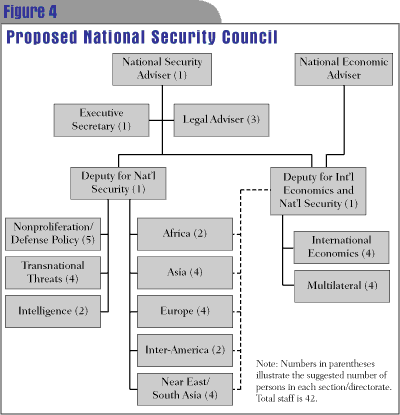
An NSC For the New Administration
With these eight characteristics as a guide, what should the NSC look like in the new administration? In our view, the next president will be best served by a NSC structure and staff that is akin to the late Reagan, Bush, and early Clinton administrations, with a new emphasis on functional competence. The basic structure should consist of a national security adviser, supported by two deputies, and ten directorates: five regional and five functional. The overall size of the NSC should be no larger than 40-45 substantive professionals. The intent is to create an NSC that is small in size, senior and expert in competence, and adaptable to the multitude of requirements that will be placed upon it.
We propose making one major change to past practice: adding a second deputy with powers equal to those of the first. This second person, an economic specialist, would be dual-hatted: reporting both to the national security adviser and the head of the National Economic Council. She/he would have overall responsibility for international economic affairs and serve as the government’s sherpa to the G-8 economic summits. This person would also oversee the NSC’s multilateral portfolio as well as the transnational and economic issues that flow through the regional directorates, chairing all deputies’ committee meetings dealing with these issues. The other deputy would retain primary responsibility for security issues—including nonproliferation, defense, and transnational threats—as well as for traditional bilateral and regional relations.
Moving to the overall staff structure, the five regional directorates would remain similar to the past, except that Russia and all other European states would be handled by a single European Affairs unit. Although the division of labor within directorates is bound to evolve over time, the European Affairs directorate might have, under the senior director, three directors responsible for Russia, EU/NATO, and the rest of Europe respectively. Directors in Asian Affairs might deal with China, Japan/Korea, and southeast Asia, while those in Near East/South Asian Affairs might divide their responsibilities between the Persian Gulf, Arab-Israeli issues, and South Asia.
More of the NSC staff, however, should work in the five functional directorates, in view of the growing importance of these issues. The nonproliferation and defense directorates could be combined, with much of this new unit’s future work focusing on nonproliferation (of which arms control should be an integral part) rather than on defense—an area where the NSC’s impact has been marginal. Directors should focus their work on weapons of mass destruction, missiles and advanced conventional weapons proliferation, export controls, and broad defense policy. A multilateral affairs directorate would address such issues as U.S. relations with the United Nations, humanitarian and refugee policy, democracy and human rights, and environmental and health policy, thus combining responsibilities that are currently spread over a number of different directorates. A much smaller transnational threats directorate should be responsible for coordinating policy on drugs and international crime, counter-terrorism, and cyber security. The International Economic Affairs staff should remain dual-hatted with the National Economic Council, as is presently the case, and report directly to the similarly dual-hatted deputy for national security and international economic affairs. Finally, a small Intelligence Programs directorate remains necessary to coordinate activities in this realm, especially to ensure presidential control over any covert activities.
Any operational responsibilities on substantive issues should be assigned to departments or other agencies. And as emphasized above, support and liaison staffs—for press, communications, congressional relations, etc.—should return to the White House proper, where a deputy in each of these offices should coordinate work on international issues.
We advance these specific prescriptions for NSC staffing and structuring not with an eye to their adoption, in their entirety, by the next administration, but to suggest how the NSC can cover a broad range of issues yet be small enough to retain flexibility and responsiveness. The primary focus of the NSC, of its staff and its work, should be the policy issues and choices that are (or should be) the president’s business—nothing less, but also nothing more.
The NSC has survived peaks (Nixon’s first term) and valleys (Reagan’s first year) of influence. It has survived blatant misuse of power. It has survived presidential neglect. It has survived abuse of the national security adviser role. It has survived mismanagement at the top. It is a good bet to survive to its hundredth anniversary in 2047.
But survival is not the same as effectiveness, and effective organization matters in determining policy outcomes. While good organization does not guarantee good policy, bad organization makes bad policy much more likely. Getting top-level government organization right is therefore enormously important.
The NSC is uniquely situated to manage the policymaking process in ways that ensure the president and his senior advisers know the full range of options—including the advantages and drawbacks of each—when making decisions. If left to the departments, policy options will invariably reflect their bureaucratic interests, or the least common denominator among them. But unless properly structured, the NSC will not play this crucial role.
Only the president has the power to make this happen. That is why the decisions the new president makes about the NSC in the next few weeks will do much to determine the success or failure of his foreign policy during the next four years.
This Policy Brief is a product of the National Security Council Project, a collaborative undertaking of the Center for International and Security Studies at Maryland and the Brookings Institution.
